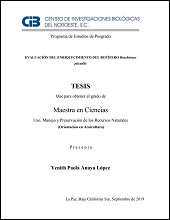Mostrar el registro sencillo del ítem
Evaluación del enriquecimiento del rotífero Brachionus
| dc.contributor.advisor | MALDONADO GARCIA, MINERVA CONCEPCION | |
| dc.contributor.author | ANAYA LOPEZ, YENITH PAOLA | |
| dc.date.issued | 2019 | |
| dc.identifier | https://cibnor.repositorioinstitucional.mx/jspui/handle/1001/1689 | |
| dc.identifier.uri | http://dspace.cibnor.mx:8080/handle/123456789/2993 | |
| dc.description.abstract | "Los rotíferos son los organismos más usados como alimento para las primeras etapas larvarias en la acuicultura. Se han desarrollado e implementado con éxito, gran variedad de técnicas para lograr masificar el cultivo de estos organismos, y por consiguiente, mejorar la producción acuícola. Sin embargo, el rotífero por sí solo, contiene un inadecuado contenido nutricional que impide el correcto desarrollo de las larvas. Por lo tanto, se hace necesario potenciar su valor nutritivo de acuerdo a los requerimientos de cada especie, mediante dietas de enriquecimiento, ya sea con microalgas, levaduras, aceites u otras dietas formuladas. De acuerdo a lo anterior, el objetivo es evaluar el efecto del tiempo en el enriquecimiento del rotífero Brachionus plicatilis con mezclas de microalgas nativas, tradicionales y un enriquecedor comercial, Ori-Green. Para esto, se escaló un cultivo de B. plicatilis y se evaluaron enriquecimientos con diferentes tiempos (1, 2, 4, 8, 12 y 24 horas) y tres diferentes dietas: 1) mezcla de microalgas nativas: Schizochytrium sp. (LPU1) y Chaetoceros sp. (LPU3); 2) mezcla de microalgas tradicionales: Chaetoceros muelleri y C. calcitrans; 3) Enriquecedor comercial Ori-Green (Skretting®). Cada experimento se llevó a cabo por triplicado, se realizaron análisis bromatológicos de todos los tratamientos y perfiles de ácidos grasos por cromatografía de gases. Finalmente, se realizaron pruebas estadísticas de homogeneidad, análisis de varianza y pruebas post hoc para comprobar si existían diferencias significativas entre los tratamientos y tiempos. Se encontró que la mayor concentración de carbohidratos se obtuvo con la mezcla de microalgas tradicionales a un tiempo de 8 horas (228.3 mg/g ± 4.1), en cuanto a lípidos totales, el tratamiento con el enriquecedor Ori-Green a 24 horas presentó la mejor concentración con 266 mg/g ±1.7 y la dieta de microalgas nativas obtuvo la mayor cantidad de proteínas totales a 4 horas de enriquecimiento (624.56 mg/g ± 0.7). Se halló una tendencia de crecimiento positivo para la cinética del ácido graso DHA en el tratamiento con Ori-Green durante las primeras 8 horas y posteriormente se mantuvo constante (11%), por el contrario, el EPA para el mismo tratamiento mostró una tendencia de crecimiento negativo y el tratamiento con microalgas tradicionales mostró los mejores resultados con un 16% de EPA. Finalmente, el ARA, fue observado en una mayor proporción en los rotíferos enriquecidos con microalgas nativas en los tiempos de 1 y 2 horas de enriquecimiento, con aproximadamente 3.64% de los lípidos totales." | es |
| dc.format | es | |
| dc.language.iso | spa | es |
| dc.publisher | Centro de Investigaciones Biológicas del Noroeste, S.C. | es |
| dc.rights | Acceso abierto | es |
| dc.subject | rotífero, enriquecimiento, microalga nativa, ácido graso, Ori-Green | es |
| dc.subject | rotifer, enrichment, native microalgae, fatty acids, Ori-Green | es |
| dc.subject.classification | NUTRICIÓN | es |
| dc.title | Evaluación del enriquecimiento del rotífero Brachionus | es |
| dc.type | masterThesis | es |
| dc.dirtesis.grado | Maestría en Ciencias en el Uso, Manejo y Preservación de los Recursos Naturales | es |
| dc.dirtesis.disciplina | Acuicultura | es |
| dc.dirtesis.universidad | Centro de Investigaciones Biológicas del Noroeste, S.C. | es |
| dc.dirtesis.facultad | Posgrado en Recursos Naturales | es |
| dc.description.abstracten | "Rotifers are the most commonly used organisms as food for the first larval stages in aquaculture. A wide variety of techniques have been developed and implemented successfully to achieve mass growth of these organisms, and to achieve, improve aquaculture production. However, the rotifer by itself, contains low quantities of nutritional content that prevents the correct development of the larvae. Therefore, it is necessary to enhance its nutritional value according to the requirements of each species, through enrichment diets, either with microalgae, yeasts, oils or other formulated diets. According to this, the objective of the present study is to evaluate the effect of time on the enrichment of the rotifer, Brachionus plicatilis, with mixtures of native, traditional microalgae and a commercial enrichment, Ori-Green. For this, a culture of B. plicatilis was scaled and enrichments were evaluated with different times (1, 2, 4, 8, 12 and 24 hours) and three different diets: 1) mixture of native microalgae: Schizochytrium sp. (LPU1) and Chaetoceros sp. (LPU3); 2) mixture of traditional microalgae: Chaetoceros muelleri and C. calcitrans; 3) Ori-Green commercial enrichment (Skretting®). Each experiment was carried out in triplicate, bromatological analyzes of all treatments and fatty acid profiles were performed by gas chromatography. Finally, statistical tests of homogeneity, analysis of variance and post hoc tests were analyzed to verify if there are significant differences between treatments and times. It was found that the highest concentration of total carbohydrates was obtained with the mixture of traditional microalgae at a time of 8 hours (228.3 mg/g ± 4.1), in terms of total lipids, the treatment with the Ori-Green enrichment at 24 hours better concentration with 266 mg/g ± 1.7 and the native microalgae diet obtained the highest amount of total proteins at 4 hours of enrichment (624.56 mg/g ± 0.7). A positive growth trend was found for the kinetics of DHA fatty acid in the treatment with Ori-Green during the first 8 hours and subsequently remained constant (11%), on the contrary, the EPA for the same treatment affected a tendency of Negative growth and traditional microalgae treatment tested the best results with 16% EPA. Finally, the ARA was seen in a greater proportion in rotifers enriched with native microalgae at times of 1 and 2 hours of enrichment, with approximately 3.64% of total lipids." | es |

